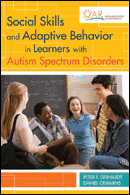My homeschooler with an autism spectrum disorder is one of many children with ASD who find reading a challenge. We continue to work hard to close the gap for her.
I opened a package from Woodbine House recently that is a fun surprise:
Try Reading Again, How to Motivate and Teach Older Beginners, Age 10 and Up by DeAnna Horstmeier, Ph.D. The book is a 297 page, easy-to-photocopy paperback of how-to and activities that includes a CD-ROM of additional resources, all aimed beginning readers who are older.
The author's approach is three-pronged, a triangle approach, that focuses on phonics and fluency on a base of language experience stories.
The book is more than reading; Horstmeier gives us direction on creating "language experience stories" with our children as well. We learn about phonics and vocabulary, too. The gems for me are the structured stories and the back part of the book, the appendices of lists and flash cards games and activities that are beginner reader friendly. We need to work on prefixes and suffixes here, and contractions, too and there are pages that guide me through that as well. I realize I've never taught her about digraphs. We have work to do.
Try Reading Again is a thorough resource that covers a broader range of development than I thought on first glance. My first flip-through impression was that it is too beginner for us, as my child can rhyme, knows letter sounds (her phonemic awareness is quite good), knows beginner sight words, etc., but as I look more closely, I see more advanced activities for my girl and as I look over topics and activities, I recognize more gaps that we need to address to make her reading experience more full, less challenging.
The activities and exercises are arranged developmentally, building foundations and growing them. If I had to choose a favorite thing inside, it would be the structured stories. Or maybe my favorite thing would be the companion CD-rom that gives me forms, worksheets, more stories.
The introduction is located
here for folks who'd like to look before they buy.
Students on the autism spectrum often have such scattered skills that we see the splinter skills without recognizing shaky foundations beneath them. I am digging in with enthusiasm as we strengthen foundations and move forward in all things reading. The activities and ideas are practical and provide in-context learning opportunities - and the activities are short yet packed with practice and experience. We need work on stories.
The book is priced at $24.95, on sale at the moment (check the web page for current pricing). A keeper, for sure.
Woodbine House sent me a review copy of this book at no charge to me. I am not paid for reviews and am not obligated to provide a positive review. RE: Federal Trade Commission's 16 CFR, Part 255: "Guides Concerning the Use of Endorsements and Testimonials in Advertising."














